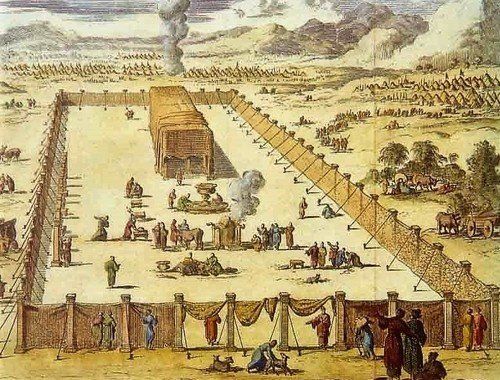Why did those two despondent disciples, foot-sore and weary from trudging on the Emmaus road, turn round and walk the eleven kilometers back to Jerusalem late that evening? Reason would have suggested a good night’s sleep and a hearty breakfast, a new day for a new deed. But they returned that evening not the next day. Why did the Eleven, lately surprised at the ghostlike figure of Jesus eating broiled fish, and filled with joy and amazement at all this, not suddenly despair when Jesus was taken from them into heaven at Bethany? On the contrary, they returned to Jerusalem with great joy and stayed continually at the temple praising God.
Something had happened to both groups. Of course, they had seen the risen Jesus and that was stupendous in itself. But more had happened. They had not only seen the risen Jesus but he had opened the Scriptures to them and explained in those Scriptures everything about himself. That was mind-boggling. It was at that point, on reflection, that the two found their hearts burning within them. That was why the Eleven came back to Jerusalem with verve and hope. Christ in the Scriptures had turned despondency to excitement and depression to purpose.
A legitimate task
That Jesus did this for his followers forever stresses the legitimacy, indeed the necessity for us to find in the Scriptures everything about Jesus. For Jesus, of course, those Scriptures were the Old Testament. Most Christians dabble in the Old Testament – a verse here, a verse there, a promise to lean on, an example to follow, a warning to heed, a piece of advice to absorb. But they seldom key into the storyline line. They never dream of finding Jesus in the Old Testament. Yet Jesus did. He actually opened up the Old Testament with that purpose in view. Throughout his ministry, Jesus had referred to the Old Testament. To him it was authoritative. What Scripture said, God said. But now Jesus does this consecutively, as in a series, from the major sections of the Old Testament, the Law, the Prophets and the Writings. He does it expositorily, too, unlocking the meaning of the saga of himself from Old Testament writ.
‘He said to them, “How foolish you are and how slow of heart to believe all that the prophets have spoken! Did not the Christ have to suffer these things and then enter his glory?” And beginning with Moses and all the Prophets, he explained to them what was said in all the Scriptures concerning himself’ (Luke 24:25-27).

The apostles eventually did what Jesus had taught. Philip evangelized the Ethiopian from the prophet Isaiah. At Damascus, Paul proved from the Scriptures that Jesus was the Messiah. On the day of Pentecost, from a host of Old Testament quotations, Peter proclaimed the lordship of Christ, the forgiveness of sins and the promise of the Spirit. Augustine was right when he wrote: ‘The New is in the Old concealed; the Old is in the New revealed.’ We need to stop dabbling in the Old Testament and start taking it seriously, as Jesus did. We need to key into the storyline, rather than simply fantasizing on favourite Old Testament texts.
A specific exercise
The surprising thing, though, is that this is not just a legitimate exercise but a specific one too. It is amazing to note the details of what, according to Jesus, the Old Testament foretells.
‘He said to them, “This is what I told you when I was still with you: Everything must be fulfilled that is written about me in the Law of Moses, the Prophets and the Psalms.” Then he opened their minds so that they could understand the Scriptures. He told them, “This is what is written: The Christ will suffer and rise from the dead the third day, and repentance and forgiveness of sins will be preached in his name to all nations beginning at Jerusalem. You are witnesses of these things. I am going to send you what my Father has promised; but stay in the city until you have been clothed with power from on high”‘ (Luke 24:44-49).
Here is not simply the fact of the coming Messiah but the details of his death and resurrection, the components of faith – repentance and forgiveness of sins, the universal implications of the covenant for all nations, even the apostolic confirmation of the gospel and the promise of the Spirit. All this Jesus had taught them throughout his ministry and all this is sourced in Old Testament Scripture. The details are amazing, the specifics startling, and the practicalities mean that there is a discoverable story-line whose parameters can be traced from Old to New Testament Scriptures.
We sometimes forget that both Old and New Testaments testify to Christ. He is the Christ in all Scripture. This is certainly more evident in the New than in the Old. But Christ’s detailed explanation here inevitably anticipates the New. Paul expressed this when he wrote of the church as ‘built on the foundation of the apostles and prophets with Christ Jesus himself as the chief cornerstone’ (Ephesians 2:20). This is what the Scriptures are principally about, namely, Christ the cornerstone, anticipated by the prophetic witness of Old Testament Scripture and confirmed by the apostolic witness of New Testament Scripture. The details of ‘Christ in the Scriptures’ carry us excitingly from the story-line of the Old to the equally fascinating story-line of the New.

A methodical plan
The task of finding Christ in the Scriptures, however, is not always the easiest of exercises. There are the most obvious cases. The prophecies we read at Christmas and Easter are among these: the promise of the seed of the woman from Genesis, the King on the donkey in Zechariah, the royal Son and the suffering Servant of Isaiah. Then, there are the less obvious hints in the story: the sacrifice of Isaac on mount Moriah, the angel of the Lord at the burning bush, the priest-king of the minor prophets. Before long it would be easy to look for and find Christ in every nook and cranny of Scripture, to arrive at supposed expositions which are really impositions on the natural meaning of the text. That will not do. Isogesis is not exegesis, and it does neither glory to Christ nor to the Scriptures of which he is the subject. Fanciful typology undermines the true meaning of this work and reduces Scripture to an interpretative chain of signs and symbols, not words coming from the mouth of God.
Some method is necessary. Guidelines within which to work are required. Truly, if Jesus affirmed this truth and used this method, then vast tracts of uncharted territory lie before us. How are we to approach the task? Accepted norms are already with us. We discover the flow of meaning within the context and interpret Scripture by Scripture. Particularly, we work at cross referencing between Old and New Testaments. Quotations, allusions and comments in the New will often throw fresh meaning on the prophetic element in the Old and provide structures to help us and to firm up the links between the testaments.

A stimulating field
This is not a restrictive but a stimulating field, too. The patriarchal stories of Genesis will not only thread the story within their own era but illustrate the start of the whole message of redemption. The furniture of the tabernacle in Exodus and the detail of sacrifices and feasts in Leviticus will, in principle, anticipate fulfilment in Christ the Temple of the Lord and the Victim sacrificed for his people. Grace will emerge predominant from Deuteronomy. Historical books will not only tell the tale of the time but show the plan for the future. Prophets, while revealing immediate fulfilment in many of their oracles, will leave ultimate promise to be claimed in the Messiah. Psalms will not only provide for private devotions and public worship but echo David’s greater Son. Wisdom writings like Job, Proverbs and Ecclesiastes will anticipate the person and teaching of a greater than Job or Solomon or any wise man in Christ himself. Ruth will be more than a romantic novel and the Song of Songs more than a biblical love guide. Above all, general themes like Messiah and covenant will emerge from the data naturally and provide the key line of entry into the whole system.
A continuing work
The story of Christ in the Scriptures will not end with the Old Testament either. The individual emphases of the four Gospel writers, each with his own distinctive flavour, will complement the overall picture of Christ, the mystery in whom are all the treasures of the Godhead, once hidden throughout ages and generations but now disclosed to the saints. The historical detail of Acts will supplement Old Testament historical background and illustrate fulfilment and development of the salvation theme – the promise of the Spirit, the apostolic confirmation of the gospel, the mission to the Gentiles and the establishing of the covenant kingdom. The letters, so often reflective of the Old Testament, will bear out the implications of the arrival of Christ in the New and underscore his person and work in clearer fashion. The vision of Revelation, like its anticipatory counterpart in the Old Testament, the vision of Daniel, will graphically disclose the climax of the story in a glorified and returning Christ. It would do less than justice to the totality of Scripture to presume that the New was any less exciting a prospect than the Old in this quest.
The quest, in addition, is not purely academic but practical and relevant. Hearts burning like the two on the Emmaus road at the end of a depressing day, vision clarified like amazed disciples before and after Bethany, wills subservient to Christ like the Ethiopian, who could not wait to find water to be baptized in Jesus’ name – these are the real results of finding Christ in the Scriptures. May these ever be our experience and move us to search the Scriptures in order to find in them the Christ who gives eternal life. For the Scriptures testify to Christ, as he himself said, ‘These are the Scriptures that testify about me’ (John 5:39).
‘Make the book live to me
O Lord Show me Thyself within
Thy Word Show me myself, then
show me my Saviour
And make the book live to me.’
Harry Uprichard



